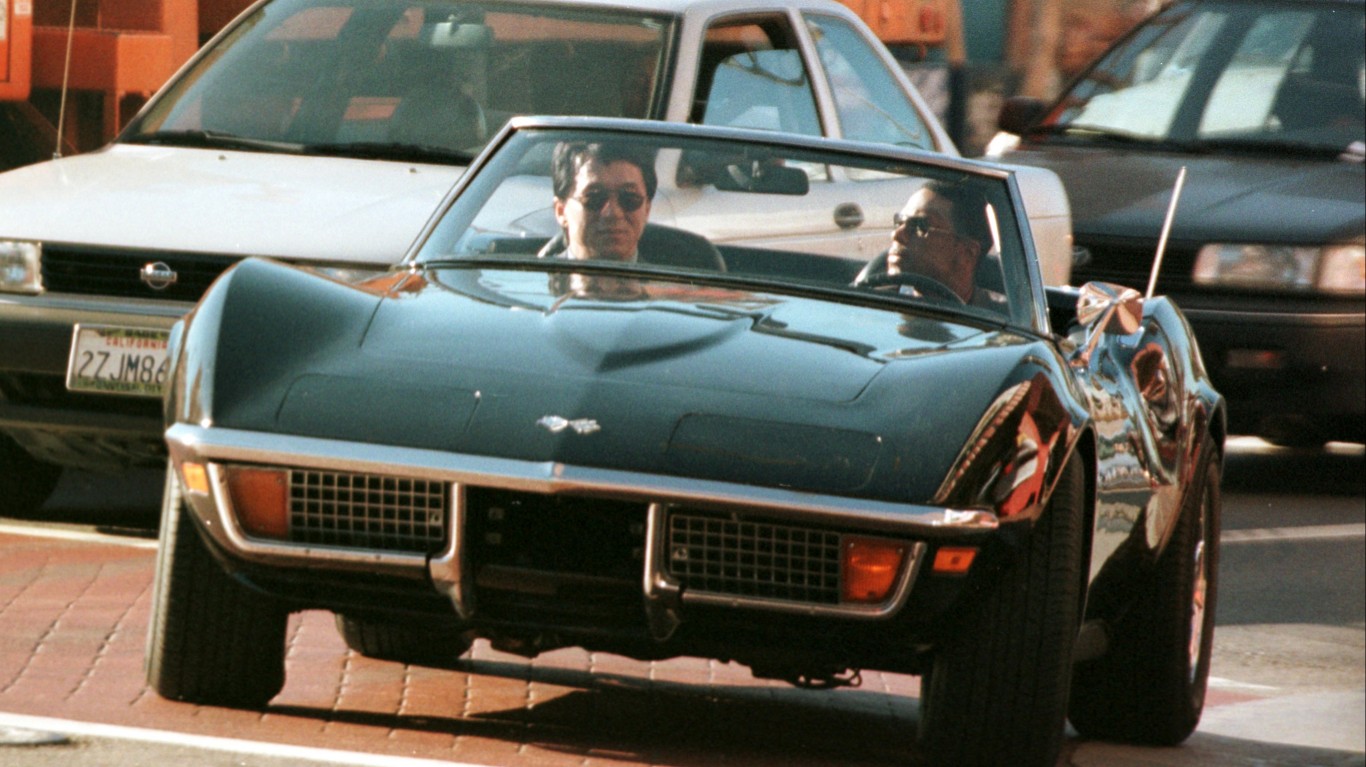
Usually it’s a novel design or special features that are either unique to the car or are some sort of breakthrough at the time introduced some sort of breakthrough. But perhaps more than anything, it’s the eventual acceptance of the car in the American psyche as iconic.
Maybe one of these iconic autos might be the first car you ever bought, like the Dodge Charger. In the 1950s, muscle cars started to muscle into the culture, with cars such as the Corvette. Another American icon, the Mustang, may have been the car you and your friends drove across the country after you graduated college.
24/7 Wall St. has reviewed various sources such as automobile information aggregator edmunds.com. and popular mechanics.com to compile a list of the most iconic classic American cars.
Though the automobile has its origins in Europe, it was in the United States that automotive travel became inextricably linked with personal liberty and freedom. And it was in America that the society-changing Model T put ordinary Americans on the road at the beginning of the 20th century, in the process becoming one of the most iconic cars in history.
Once the car became embedded in American culture, it became a gauge of trends and changing styles and tastes. The sleek, aerodynamically-styled Chrysler Airflow, produced in the 1930s, reflected the cultural impact of the Art Deco movement. After World War II, Americans gravitated toward the muscle car trend, and our list contains notable examples of such vehicles. One of the most famous of these is the Ford Mustang GT, which actor Steve McQueen drove in one of cinema’s most famous car chases — making the Ford Mustang GT one of the most iconic cars in film history.
Click here to see the most iconic classic American cars
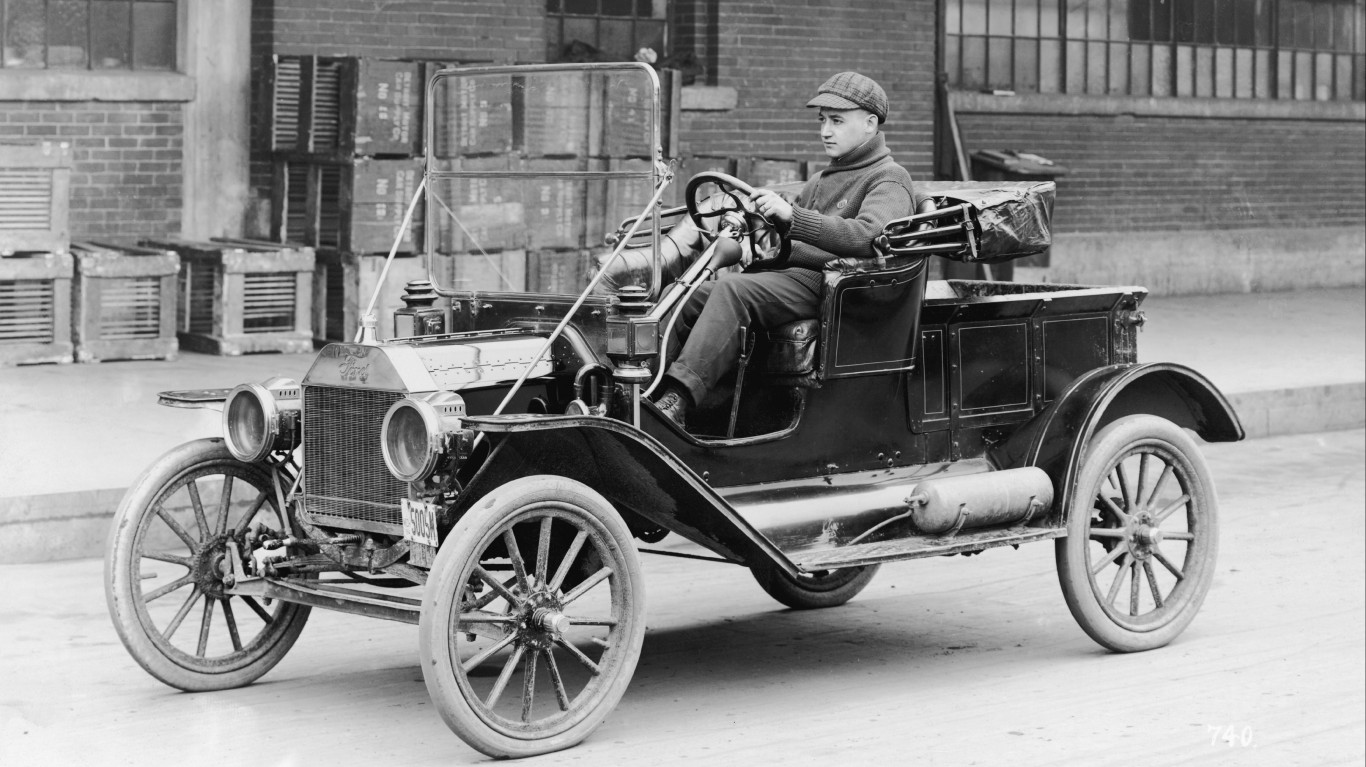
1. Ford Model T
Henry Ford revolutionized industrial production with his assembly line concept that churned out over 15 million Model Ts from 1908 to 1927. Called the “Tin Lizzie.” the car was cheap and simple to make, though its top speed was only 45 mph. The Model T democratized driving for Americans and changed the course of automotive history. At one point in the early 1920s, about half of the world’s cars were Model Ts.
[in-text-ad]

2. Duesenberg Model J
The Duesenberg was the luxury ride of its time, a car associated with the Art Deco movement of the late 1920s, a status symbol of the rich and famous, such as Clark Gable and Greta Garbo, and the preferred vehicle of European royalty. The Model J’s price tag was a cool $13,500, which translates into more than $190,000 in today’s dollars. The 1928 Model J had a 265-horsepower engine that bulked up to 320 horsepower by 1932, and it was one of the most powerful American cars before World War II.

3. Cadillac V16
Though just 4,076 of these were built over their 11 years in production, the Cadillac V16 set the standard for American luxury transportation. Veteran rock musician Neil Young owned a Cadillac V16 before he sold it to collectors from the East Coast.
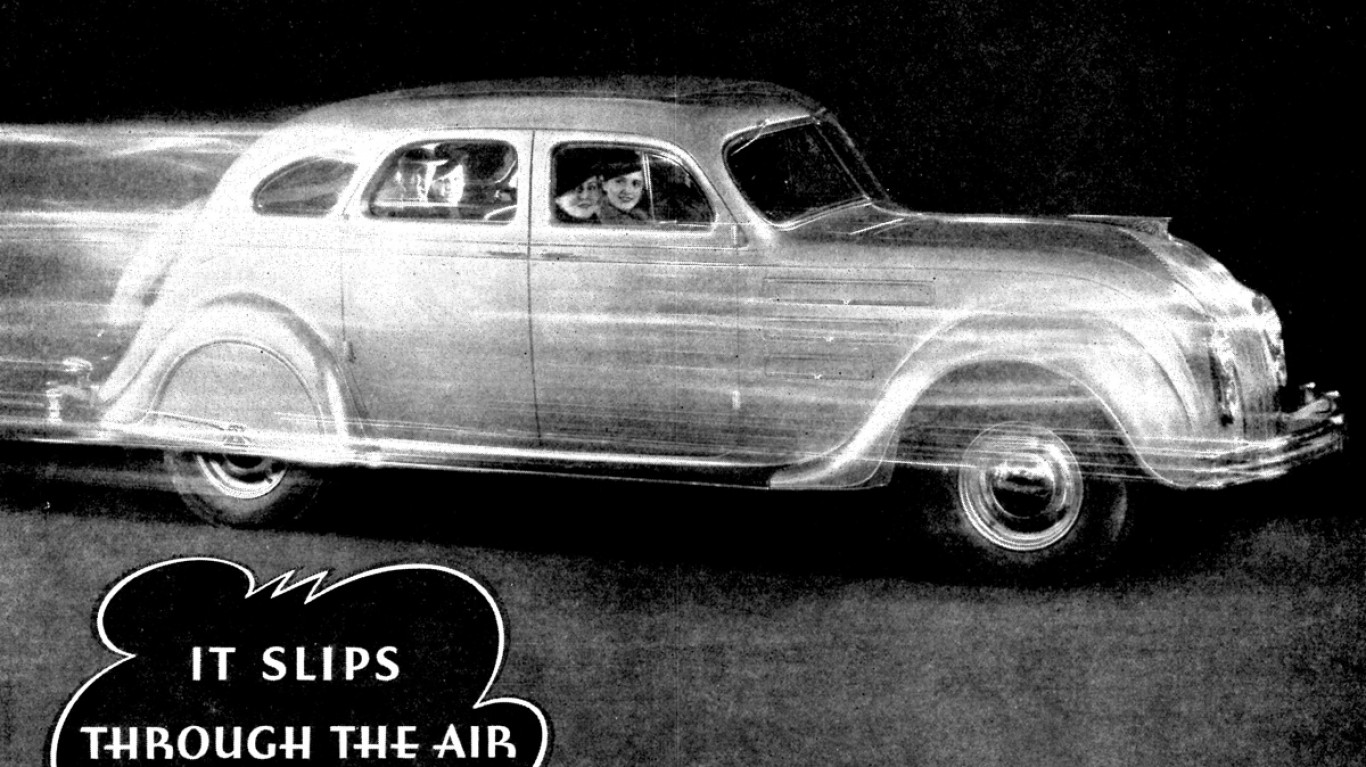
4. Chrysler Airflow
The Chrysler Airflow’s pioneering aerodynamic look made an impression on the automotive industry. In a publicity stunt to show its strength in the 1930s, the car was dropped off a cliff and then was driven away. Unfortunately for Chrysler, the timing of the introduction was bad, as the pricey vehicle came along during the Great Depression. The Airflow would not be fully appreciated until years later.
[in-text-ad-2]
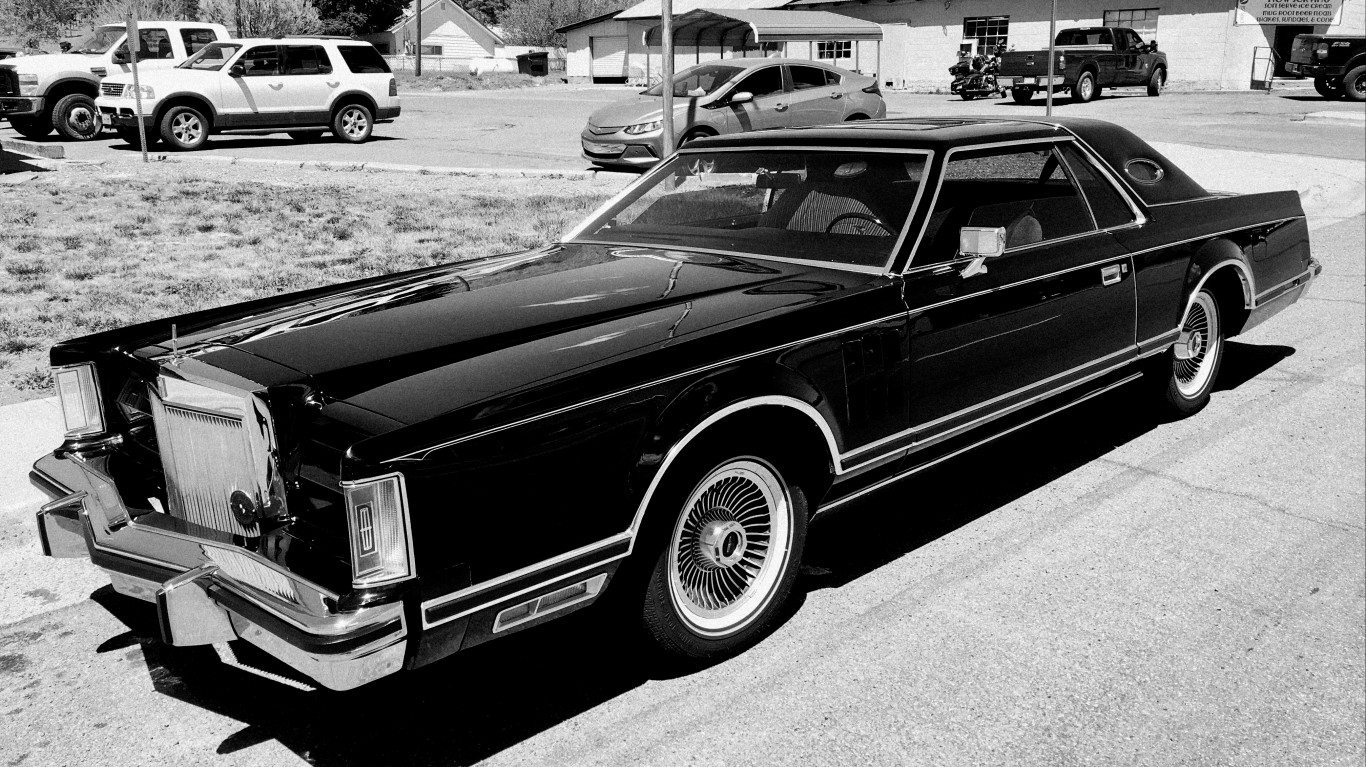
5. Lincoln Continental
Before his name became associated with one of the greatest launch debacles in automotive history, Ford Motor Company President Edsel Ford created the concept of the “personal luxury” car, with an elongated hood and a tire on the back. The Continental was a star in the Ford stable for decades.

6. Cadillac Eldorado
The Eldorado was a specialty luxury coupe that offered state-of-the art comfort, features, and the highest level of luxury for an American car. The Eldorado name was first proposed for the company’s 1952 Cadillac Golden Anniversary show car. There were 10 generations of the luxury vehicle production ceased in 2002.
[in-text-ad]
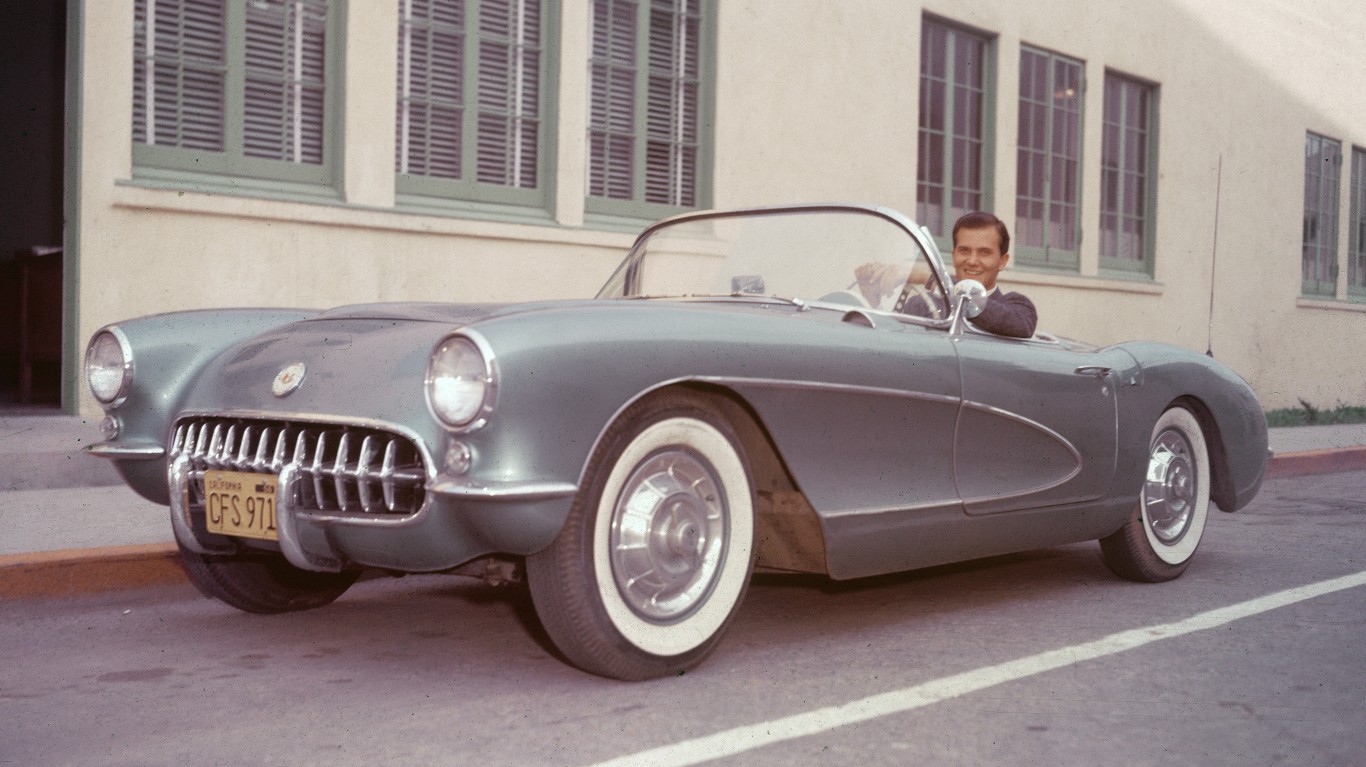
7. Chevrolet Corvette
The legendary Corvette launched the muscle car culture in the 1950s. Power, personality, and performance made the Corvette the “it” sports car of its generation. Such is the stature of the Corvette that it even has its own museum — the National Corvette Museum in Bowling Green, Kentucky, which opened in 1994.
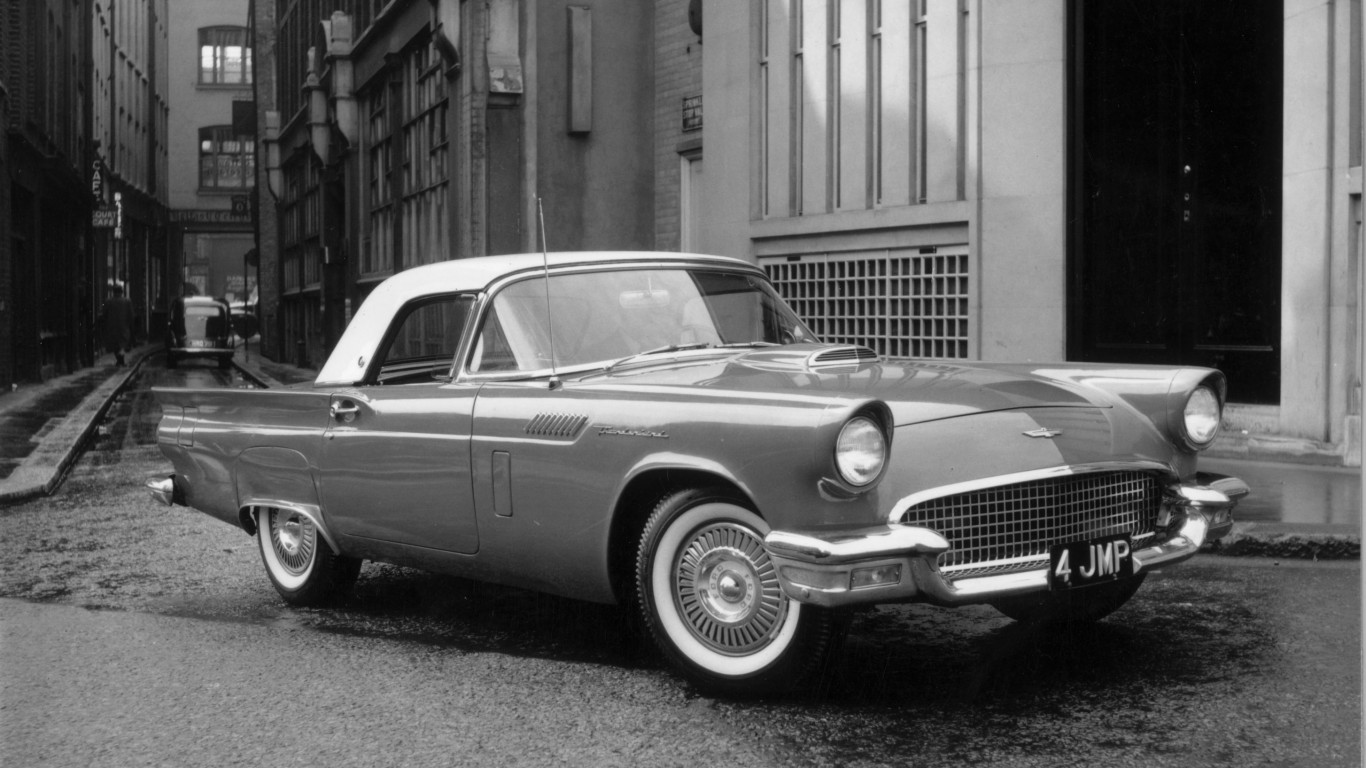
8. Ford Thunderbird
The T-bird was a very popular full-size luxury car that lasted over 11 car generations. After Ford’s European-styled Vega failed to generate interest in the early 1950s in America, Ford introduced the Thunderbird in 1955. It was more American in style than the Vega, more luxurious, and sportier. It gained a second row of seats in 1958 and became bigger in succeeding generations.
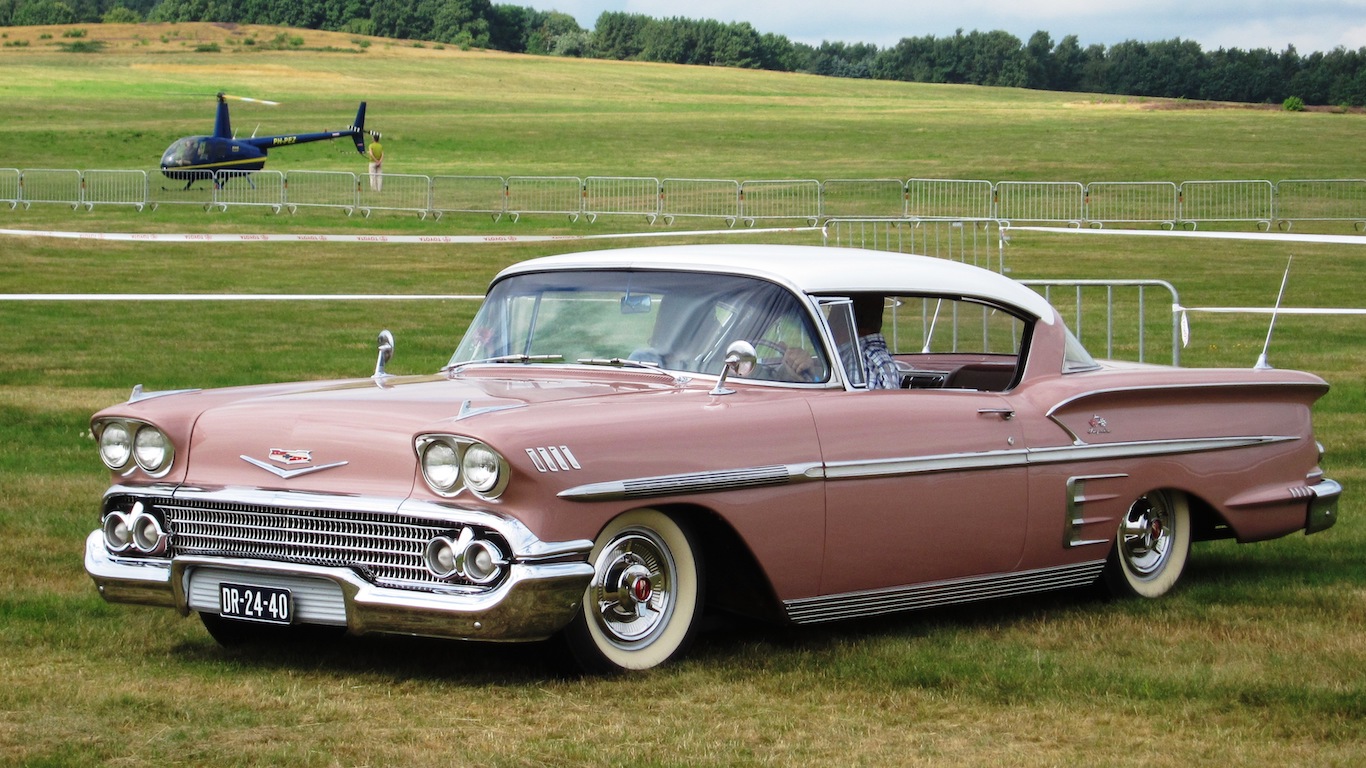
9. Chevrolet Impala
The Impala is the quintessential affordable full-size car, though its journey to classic car status hit some bumps along the road and it was out of production from 1985 to 1994. The Impala has been one of the better-selling full-size family vehicles in the United States.
[in-text-ad-2]
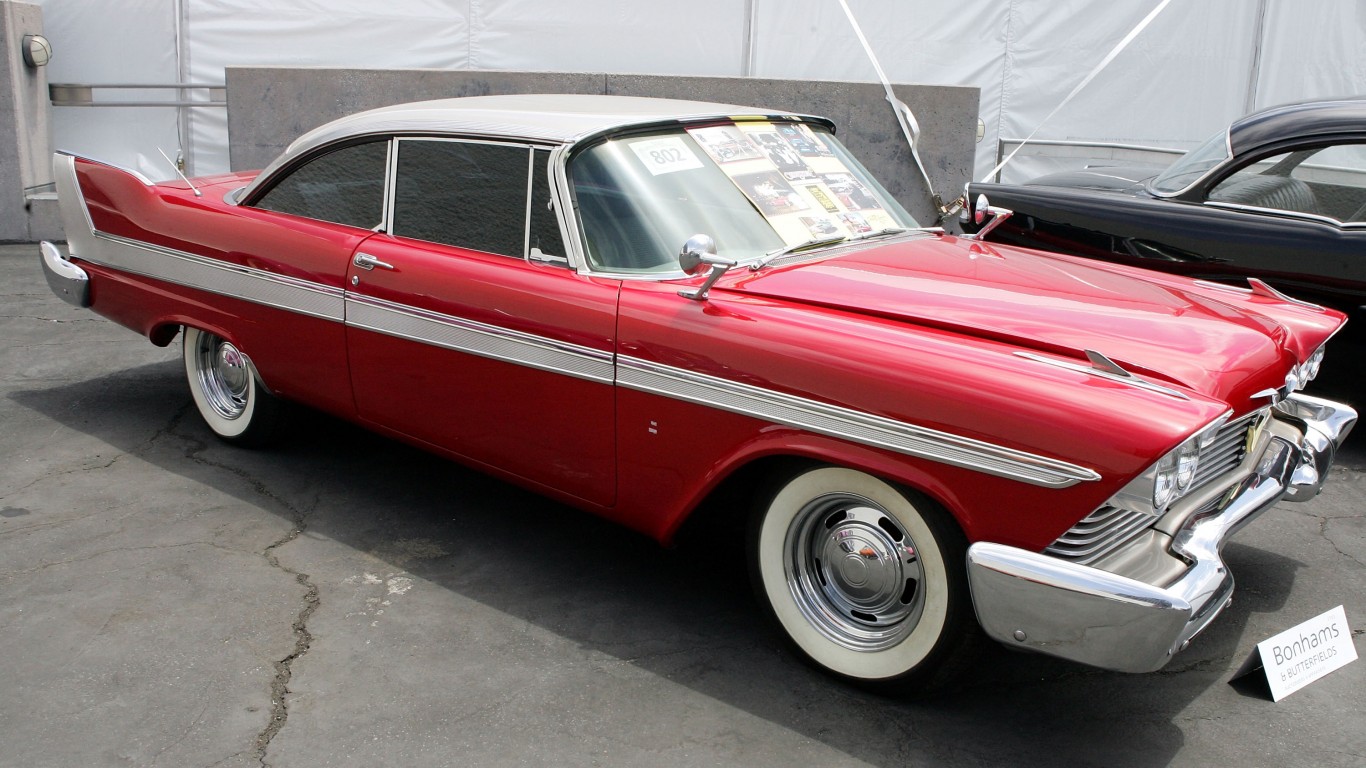
10. Plymouth Fury
The makers of the Plymouth Fury can thank prolific writer Stephen King for elevating the vehicle to cult status. The Fury is what inspired King to write the classic horror novel “Christine” — a red 1958 Plymouth Fury. It’s commonly referenced that King chose a 1958 Plymouth Fury because he didn’t want a car that already had mystique, such as the 1950s Thunderbird.
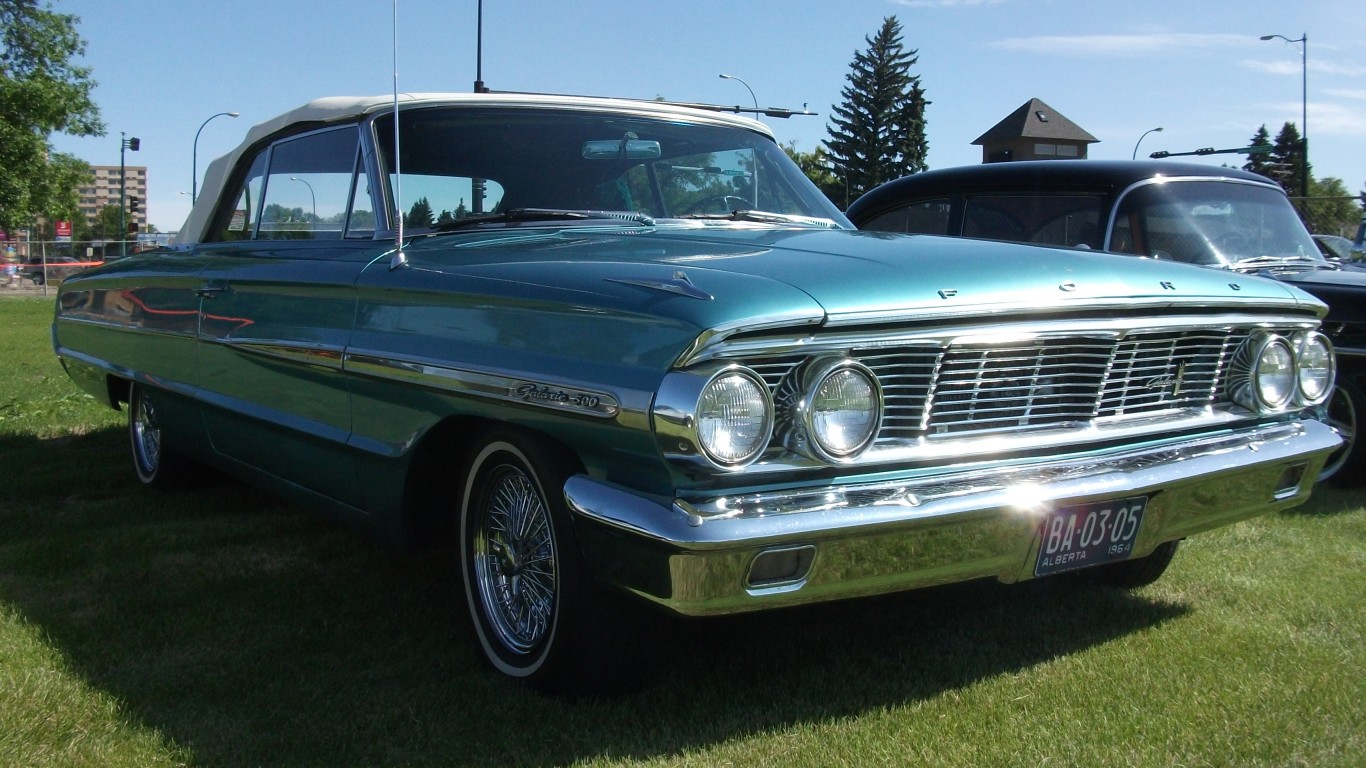
11. Ford Galaxie
The Ford Galaxie was a conservatively styled, well-selling car that was owned by Elvis Presley and Fidel Castro. The car was available with a 300-horsepower V-8 engine, but most buyers chose the more economical model with 225 or 200 horsepower
[in-text-ad]
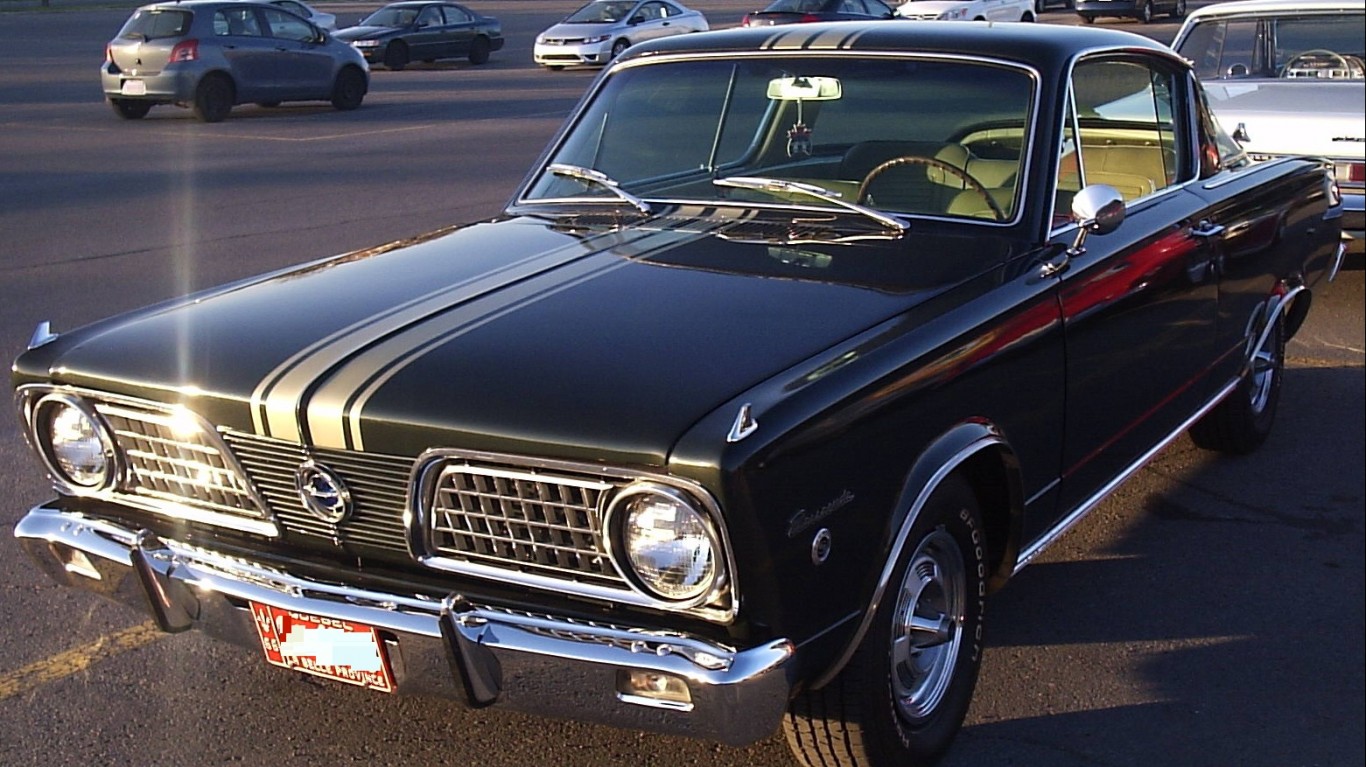
12. Plymouth Barracuda
The Barracuda was produced to compete with the wildly successful Ford Mustang at the end of the muscle car era in the 1960s. The second generation Barracuda, beginning in 1967, was redesigned and available in hardtop coupe and a convertible. Chrysler ended production of the car in 1974.
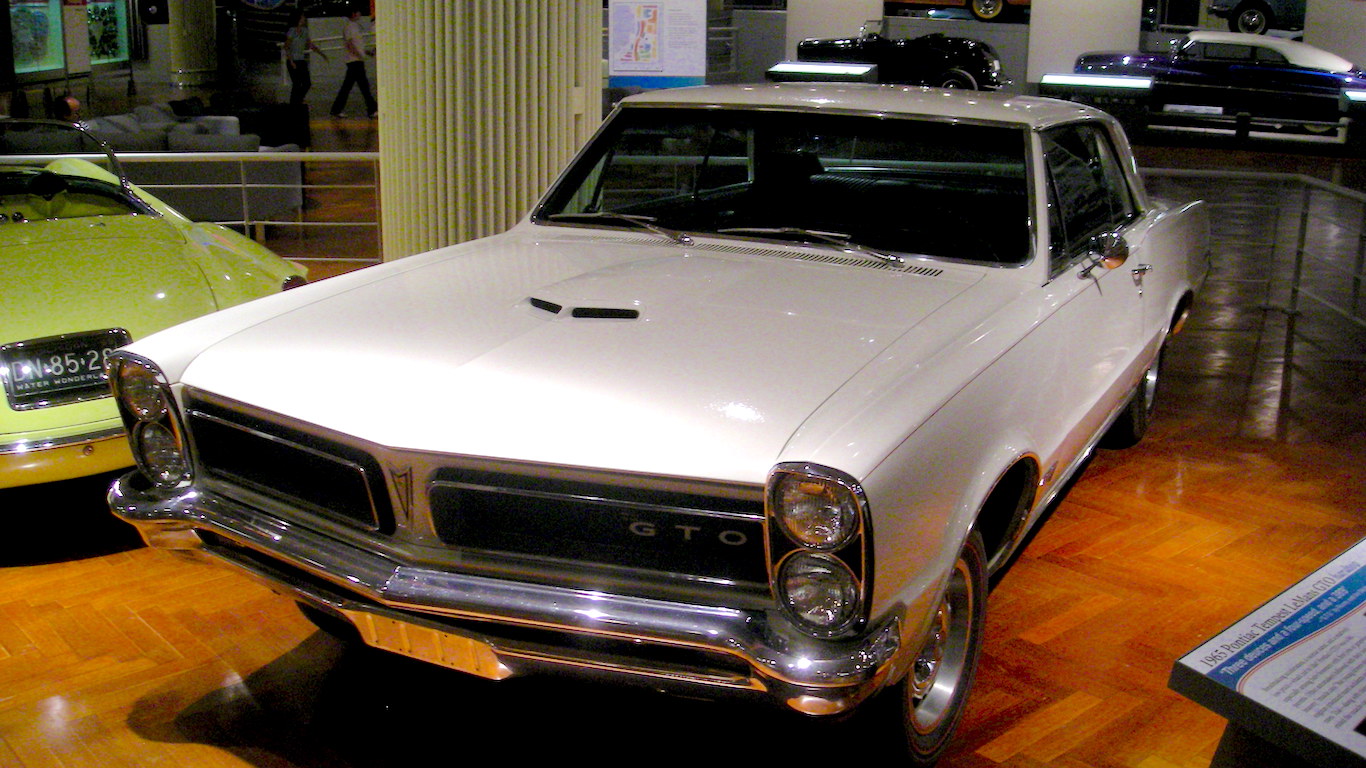
13. Pontiac Tempest Le Mans GTO
The 1964 Pontiac Tempest Le Mans GTO is an affectionately remembered entry of the American muscle car stable. GTO stands for Gran Turismo Omologato, whose approximate translation means a production grand touring machine sanctioned for competition. The car was the brainchild of John Delorean, and it was originally produced as a two-door coupe in hardtop and as a convertible.
[in-text-ad-2]
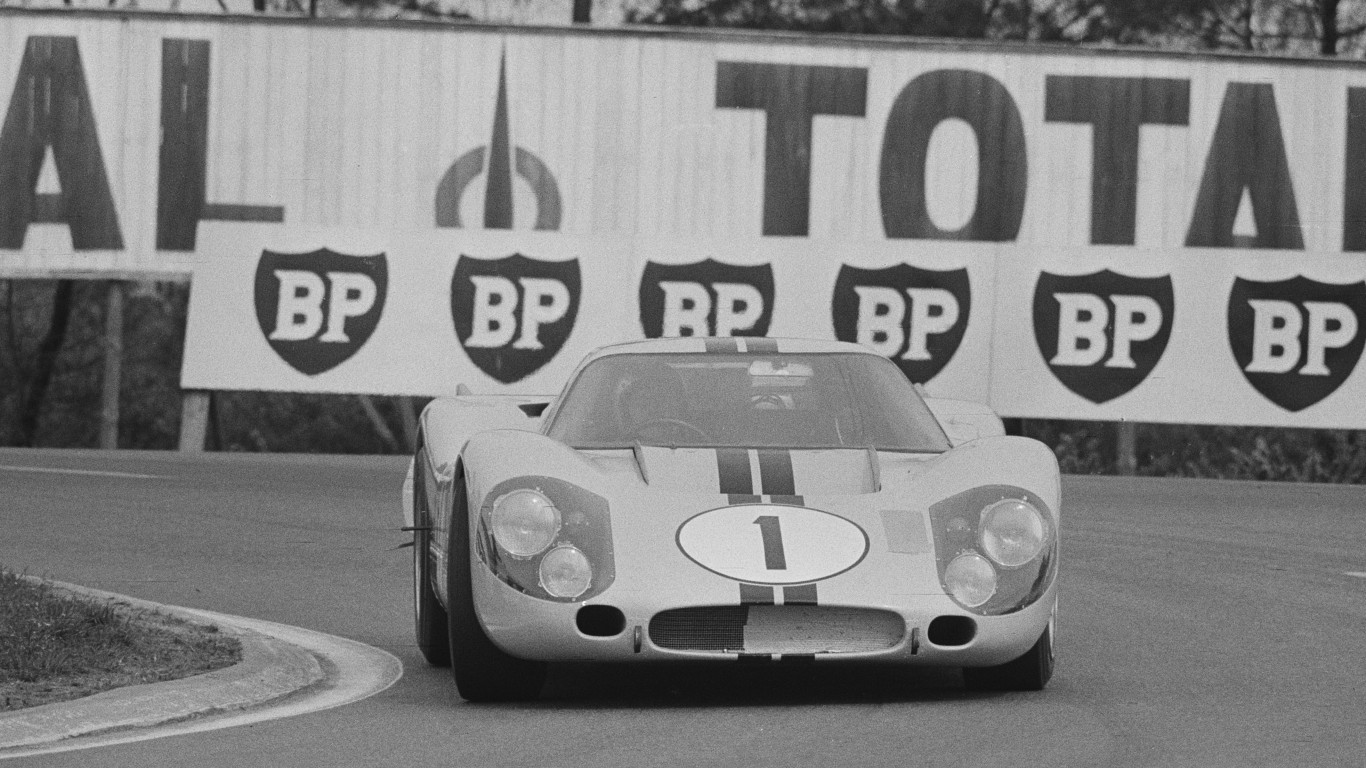
14. Ford GT40
The 1964 Ford GT40 is famous for dominating endurance races in the mid to late 1960s. It’s also famous for how it was created. Henry Ford II was furious at Enzo Ferrari for withdrawing from a deal in which Ford would take over the Italian car maker. Ford sought revenge by ordering his engineers to build a car that would humiliate Ferrari. They built the GT40, and starting in 1966, the GT40 won the 24 Hours of Le Mans four straight times. The car remains one of the great examples of American automotive engineering.

15. Chevrolet Chevelle Malibu SS
The Chevrolet Chevelle was a mid-sized muscle car produced from 1964 through 1977. The 1965 Chevrolet Chevelle Malibu SS is considered by car enthusiasts as a classy muscle car. Its subdued look was a step back from the sleeker, Space Age-inspired designs of autos in the early 1960s.
[in-text-ad]
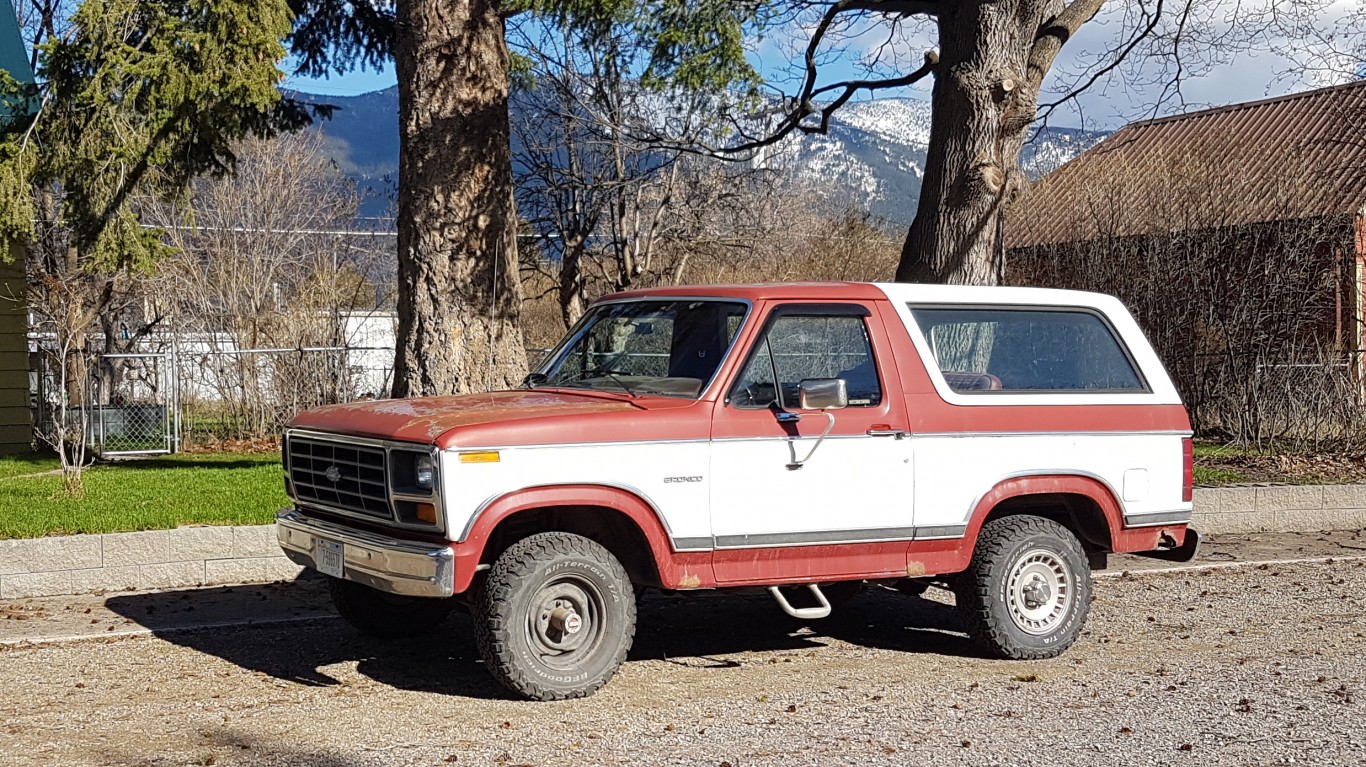
16. Ford Bronco
The first-generation Ford Bronco, though not exactly an SUV, was an offroad vehicle that appealed to the car-buying public. The Bronco is one of the most recognizable American vehicles, spanning five model generations before it was discontinued in 1996. It also got some unwelcome recognition as the car O.J. Simpson was riding as he was pursued by police in Los Angeles following the murders of his ex-wife Nicole Brown Simpson and Ron Goldman in 1994.

17. Pontiac Bonneville
1967 Pontiac Bonneville was offered as a two-door and four-door hardtop, convertible, and a sedan. The Bonneville was considered to be Pontiac’s most powerful full-size model. The average cost of a Pontiac Bonneville in 1967 was $2,750.
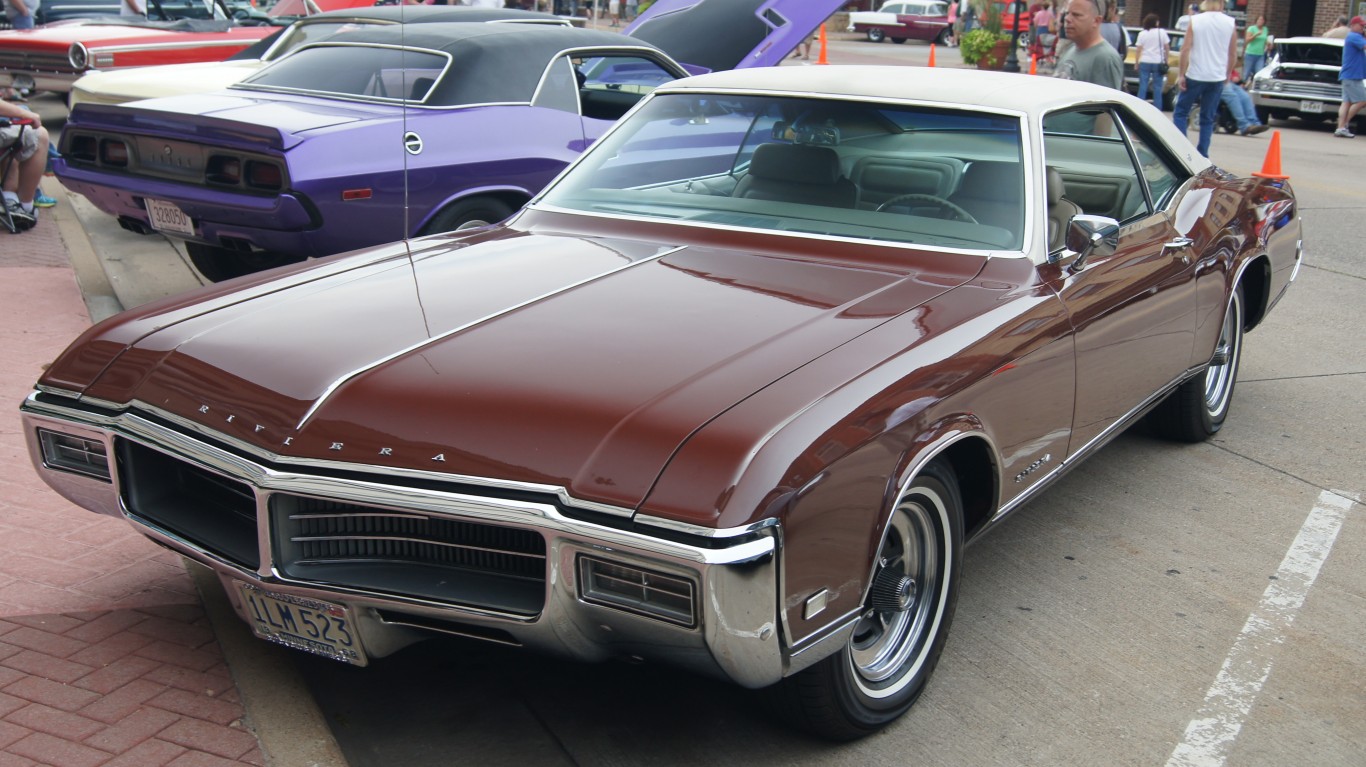
18. Buick Riviera
The Buick Riviera came on the scene at the peak of high-performing muscle cars, featuring a big engine and top speeds. Riviera helped Buick sales in 1969, selling 52,872 Buick Riviera cars.
[in-text-ad-2]
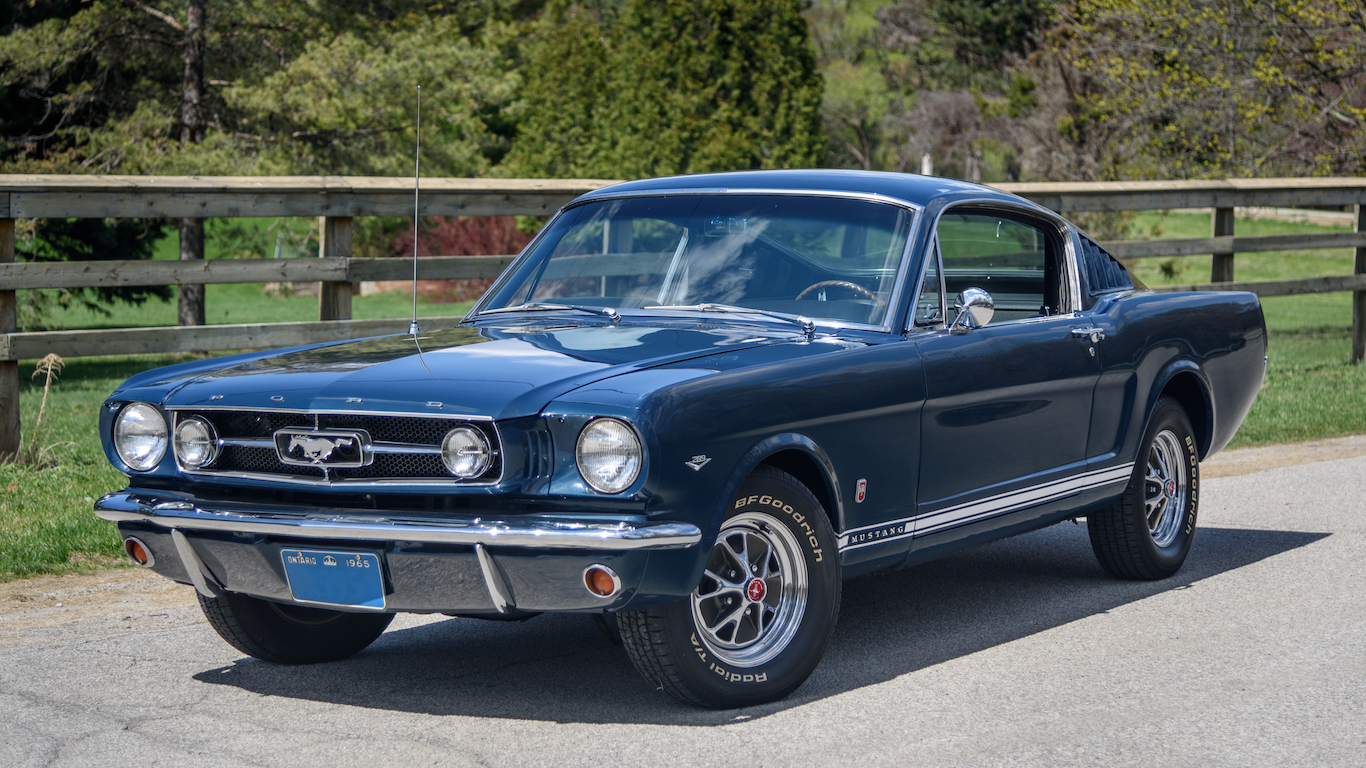
19. Ford Mustang GT
Actor Steve McQueen helped enshrine the Ford Mustang GT into immortality, driving it during one of cinema’s most famous car chases in the movie “Bullitt.” Posters of the car adorned the walls of kids’ room all over America in the 1970s. The vehicle from the movie was displayed at the fourth annual Cars at the Capital event in Washington, D.C. last year.

20. Chevrolet Camaro
GM’s iconic muscle car was introduced in 1966 as a competitor to the wildly popular Ford Mustang. To clarify this was a rivalry, GM product managers told the automotive press when the vehicle was unveiled that the name “Camaro” meant “a small, vicious animal that eats Mustangs.” The Camaro is still in production, but the 1960s models are among the most-sought after vehicles among classic car aficionados, with the 1969 Camaro Z28 near the top of the list.
[in-text-ad]

21. Ford Torino
The Ford Torino, named after the Italian city of Turin, was considered to be an upscale version of the Ford Fairlane. It became known for its fastback body, which was reminiscent of the Ford Mustang. It came in a coupe, hardtop, and sedan. The fastback coupe had sales of more than 74,000 units.
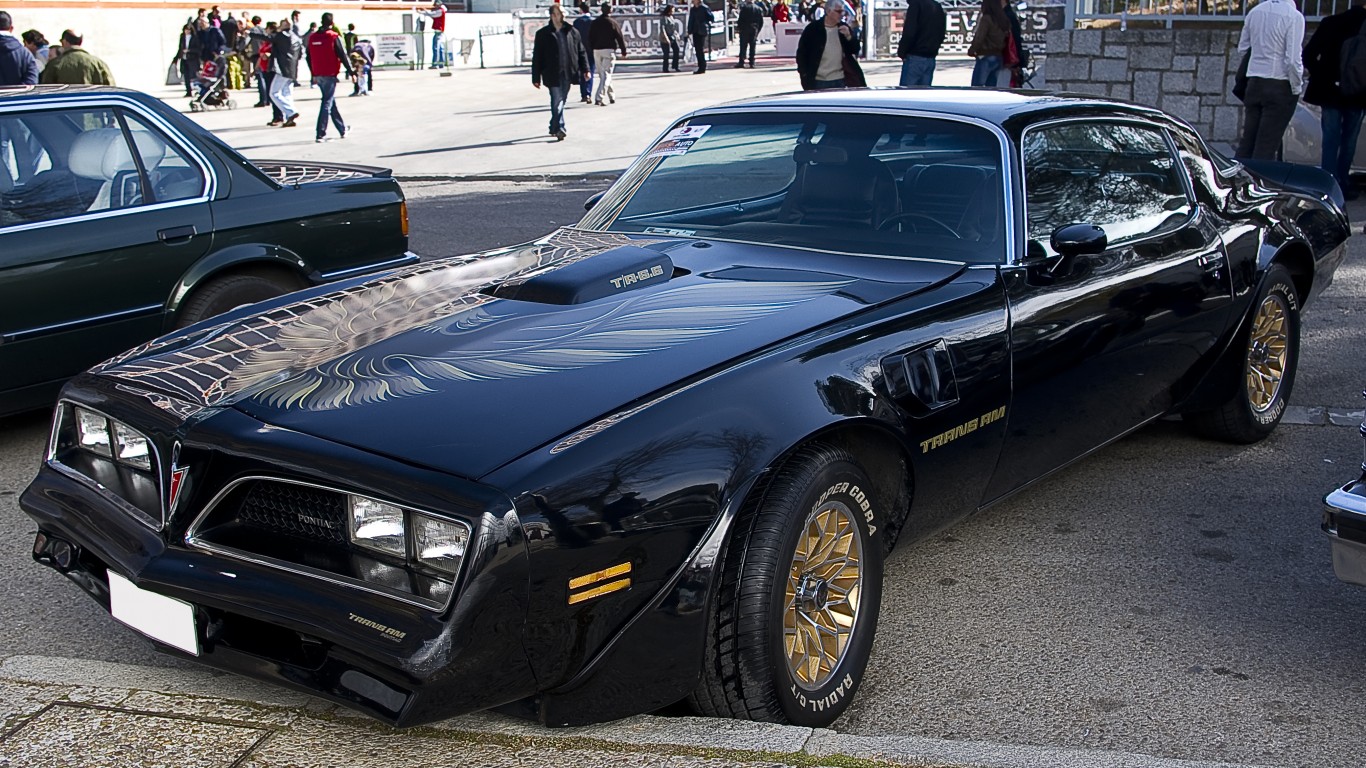
22. Pontiac Firebird Trans Am
The 1969 Pontiac Firebird Trans Am is considered a muscle car, though some car enthusiasts consider it as something more than that. The name comes from the Trans American racing series. The car, however, never competed in that event.
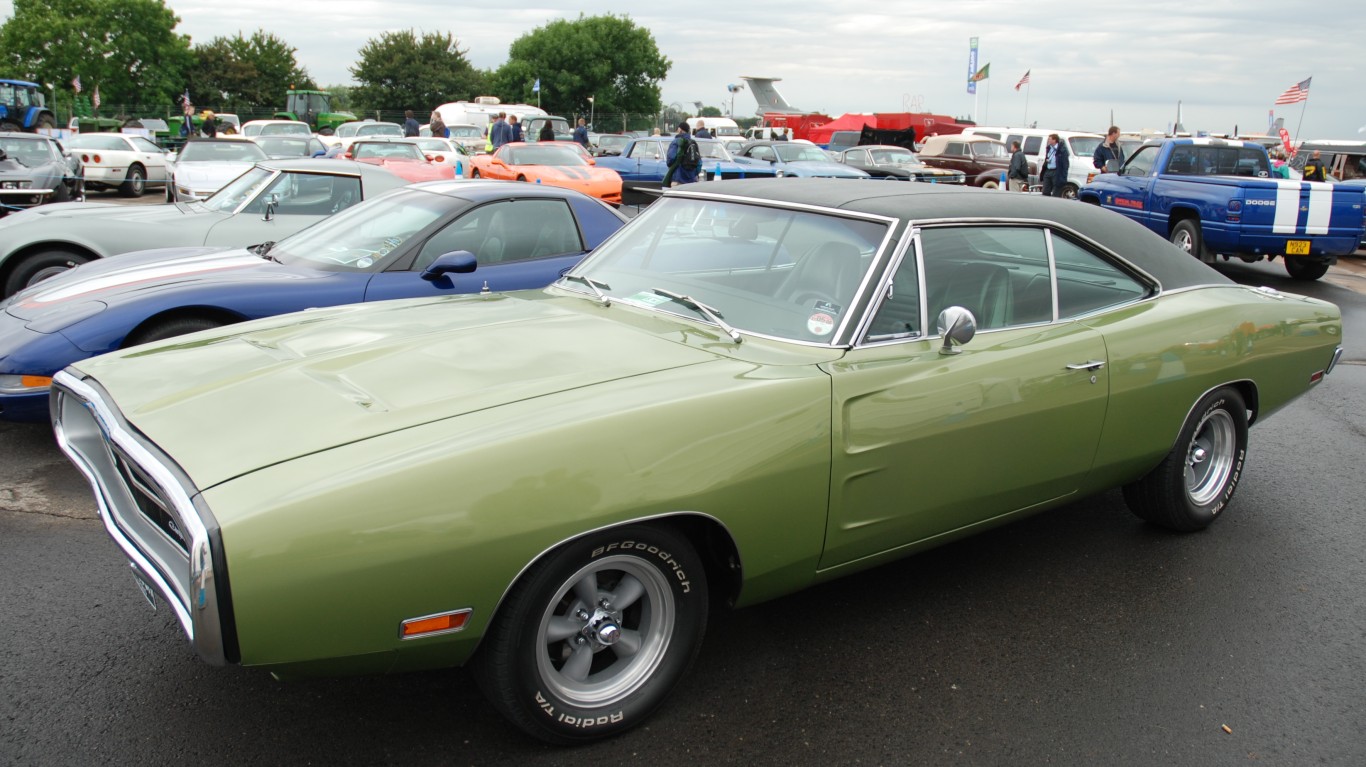
23. Dodge Charger
Speaking of muscle cars, the Dodge Charger is on anyone’s list as an iconic muscle car from the late 1960s. A Charger had a starring role in the 1970s television show “The Dukes of Hazzard.”
[in-text-ad-2]
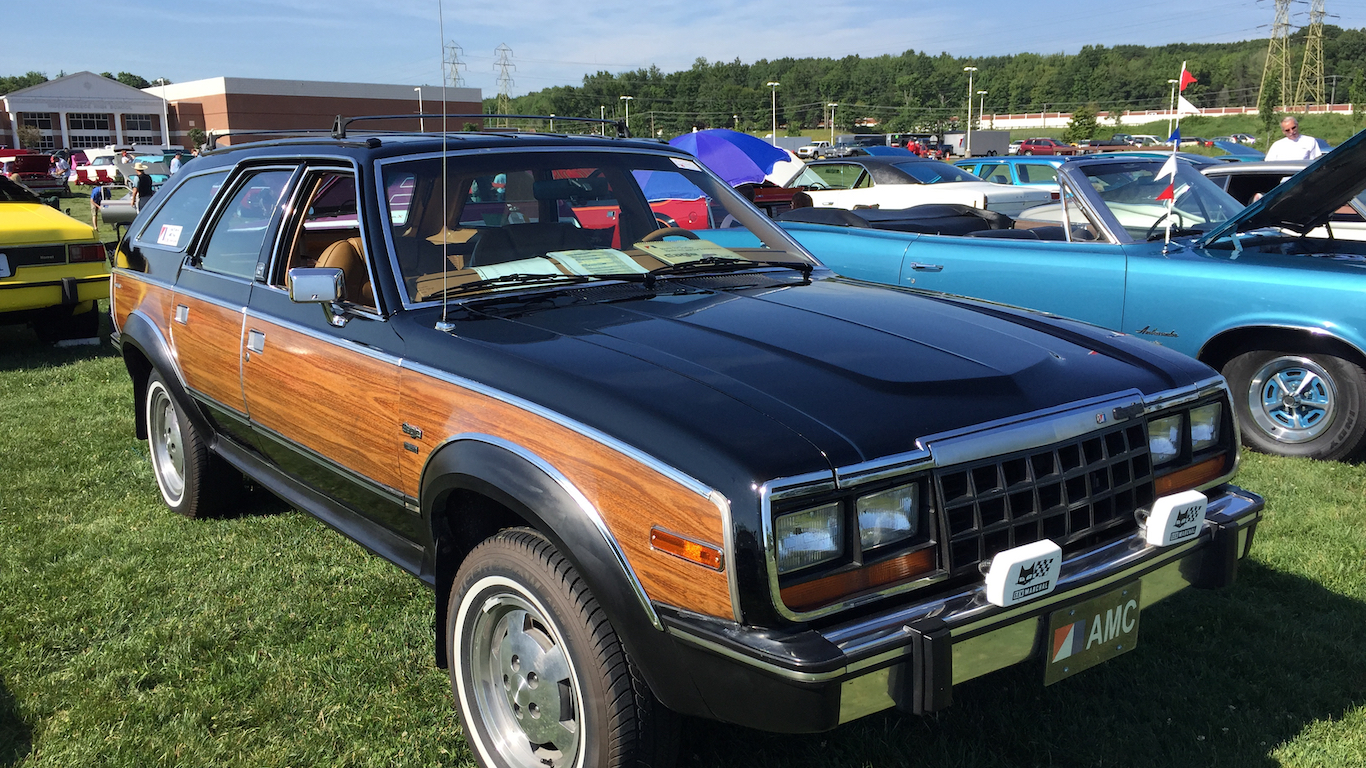
24. AMC Eagle
As the 1970s were drawing to a close, the fortunes of the American Motors Corporation were fading as well. The company needed a winner and came up with the AMC Eagle, produced as a sedan, coupe, and wagon with greater ground clearance. The vehicle also had an all-wheel drive system, making it one of the early crossovers. The car was a success, with 121,293 cars sold in its first year, surpassing the combined sales of every other AMC car that year. It was not, however, enough to save AMC.

25. Ford Taurus
Ford sunk $3.5 billion into researching and developing the Taurus. It was a gamble, but it might have saved the company from bankruptcy. Ford’s design, engineering, and marketing teams worked in tandem, using feedback from focus groups on what consumers wanted in a car. The result was a car that wowed the automotive press with its styling, handling, fuel economy, and noise reduction. The Taurus would influence the look of American vehicles in the 1990s. Motor Trend magazine named the Taurus car of the year in 1986.
[in-text-ad]
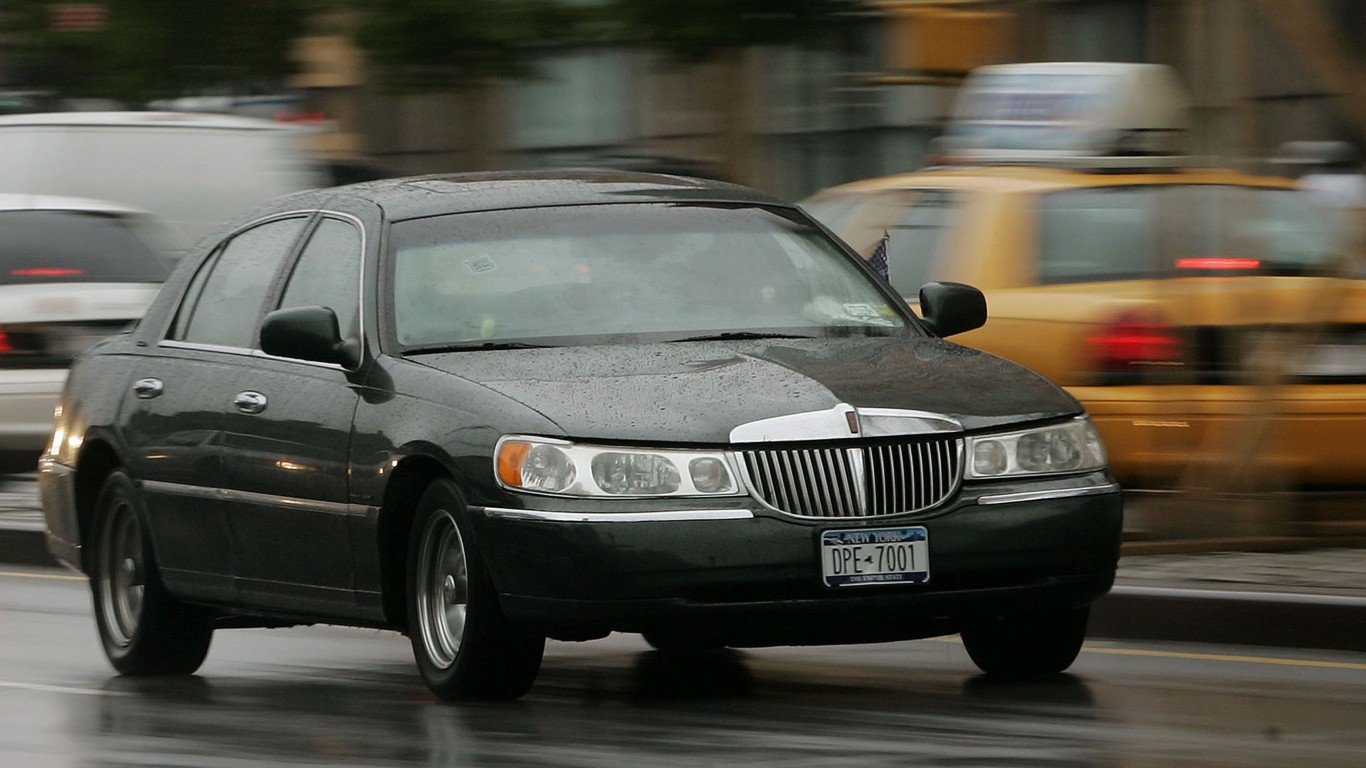
26. Lincoln Town Car
Maybe driving the Lincoln Town Car was more like handling a boat, but for passengers the ride was very smooth. The Town Car received a new body in 1998, though it kept the rear chassis it had had since 1980. It proved to be a durable vehicle and was favored by limo drivers.
Take This Retirement Quiz To Get Matched With An Advisor Now (Sponsored)
Are you ready for retirement? Planning for retirement can be overwhelming, that’s why it could be a good idea to speak to a fiduciary financial advisor about your goals today.
Start by taking this retirement quiz right here from SmartAsset that will match you with up to 3 financial advisors that serve your area and beyond in 5 minutes. Smart Asset is now matching over 50,000 people a month.
Click here now to get started.
Thank you for reading! Have some feedback for us?
Contact the 24/7 Wall St. editorial team.
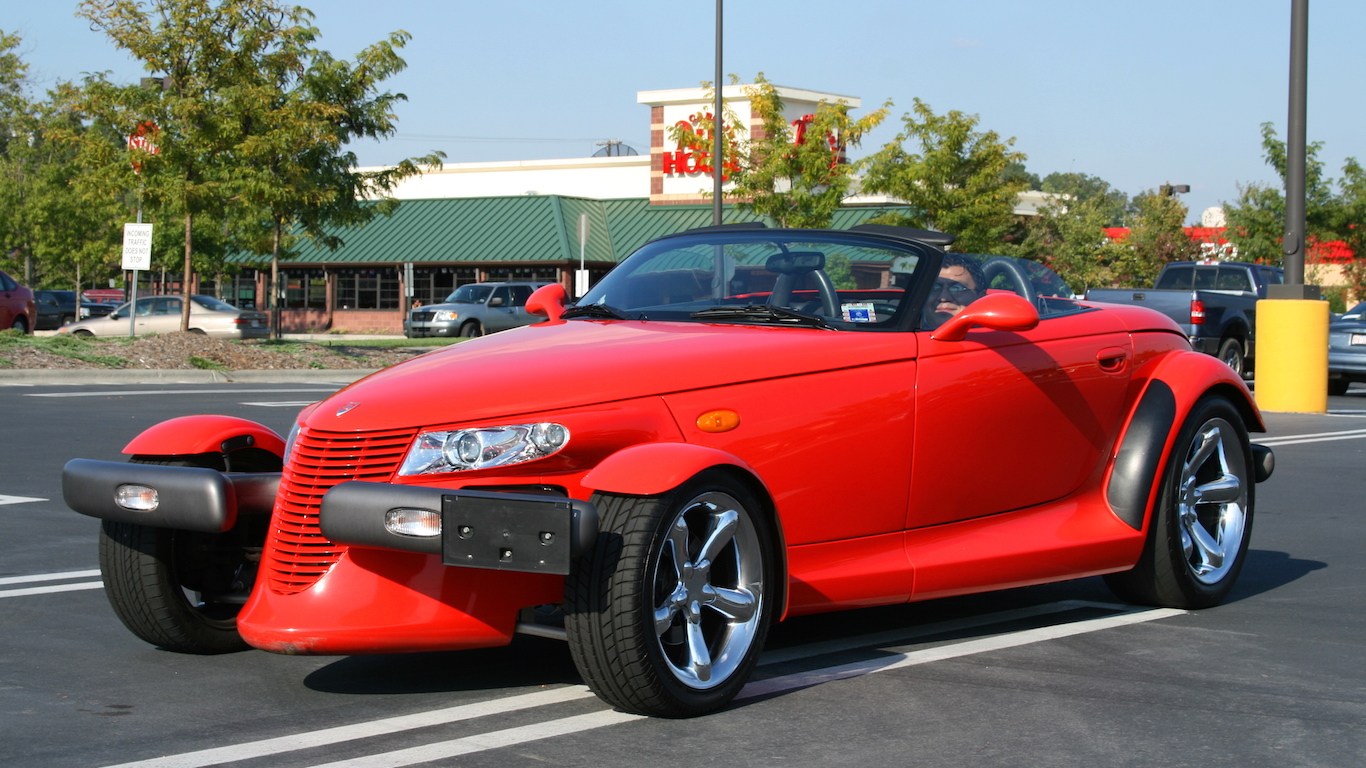 24/7 Wall St.
24/7 Wall St.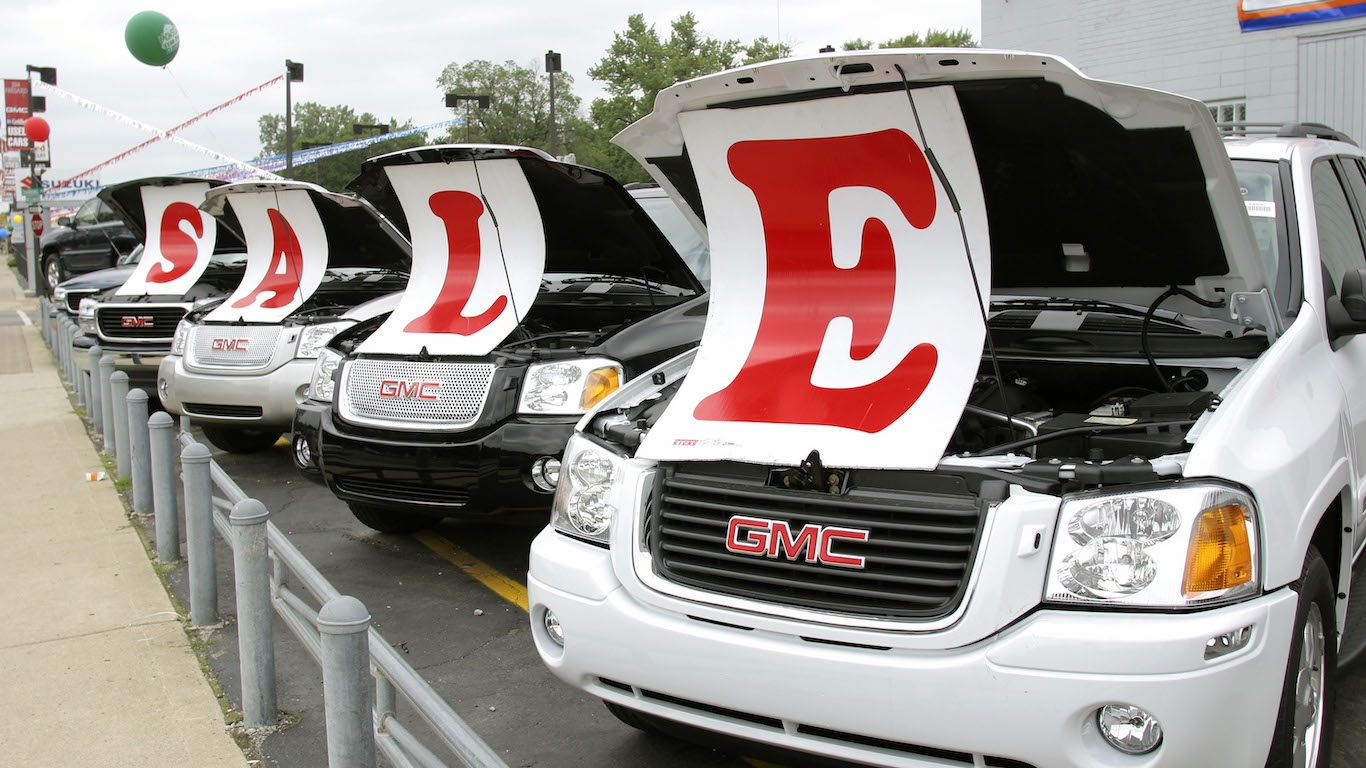 24/7 Wall St.
24/7 Wall St. 24/7 Wall St.
24/7 Wall St.


